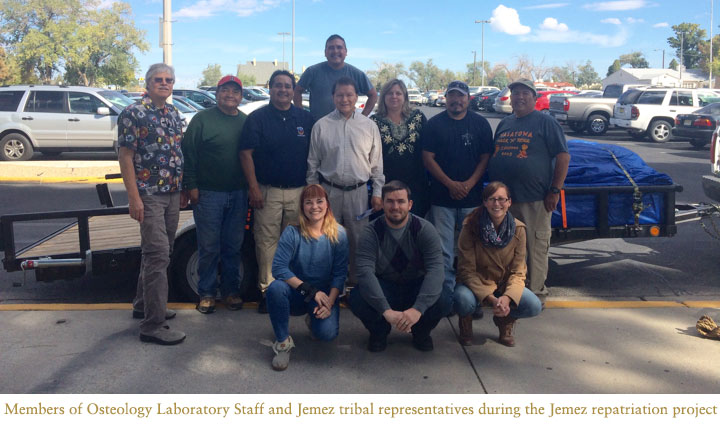
NAGPRA, the Native American Graves Protection and Repatriation Act, became law on November 16, 1990. Through NAGPRA, restrictions were enacted to protect Native American burial sites and cultural objects. NAGPRA extends protection to any federally recognized Indian Tribe or Native Hawaiian or Alaskan group. Additionally a process was put into place for museums to repatriate these items. Repatriation can include long-term storage, return or reburial of sacred objects, objects of cultural patrimony, and funerary objects, including ancestral (human skeletal) remains and burial artifacts. Relationships with the tribes are the most important part of the NAGPRA process.
The Maxwell Museum is an active participant in the NAGPRA process and has worked closely with many tribes to repatriate objects. Among recent repatriations, over 400 ancestors were repatriated to the Jemez Pueblo between 2013 and 2015. As part of the repatriation project, anthropologists from the Maxwell Museum documented ancestral remains, composed a report of findings, and returned the remains for reburial.
Maxwell Response to New 2024 NAGPRA Regulations:
The UNM Maxwell Museum of Anthropology cares for collections of Native American art, objects, and artifacts. Museum staff are committed to upholding the legal and ethical principles of the Native American Graves Protection and Repatriation Act (NAGPRA). The updated NAGPRA regulations that went into effect January 12, 2024, include new provisions related to the exhibition of and access to Native American cultural items, including funerary objects, sacred objects and objects of cultural patrimony. In response to these provisions, some museums have temporarily closed their exhibits.
Beginning in 2019, Maxwell Museum staff undertook a detailed review of all objects in our permanent exhibition People of the Southwest. This review identified objects that should be taken off display out of respect for our tribal partners. All of these objects have been removed. Because we have worked diligently over the last five years to remove from display objects subject to NAGPRA, we have decided not to close our exhibitions at this time.
The Maxwell is in the process of developing new temporary exhibitions in partnership with tribal and community scholars, artists, and culture bearers. We are also working to reimagine our permanent Southwest exhibition together with a Native advisory committee. All of our exhibitions will be subject to formal consultations before they are finalized and opened to the public. Maxwell staff are committed to engaging in consultations under the new NAGPRA regulations to ensure that there is free, prior, and informed consent for objects displayed in all of the Maxwell’s exhibitions.
As we at the Maxwell work to ensure our adherence to the requirements of the new regulations, we expect there may be further modifications to our programs, exhibitions, and collection access. We will be transparent in informing our community as these develop. The Maxwell Museum is committed to abiding by and upholding NAGPRA and looks forward to continuing and deepening our relationships with tribal partners